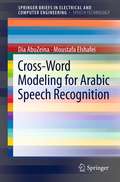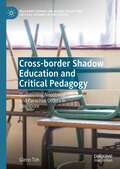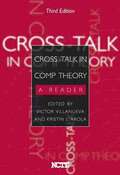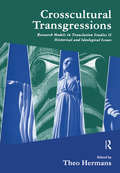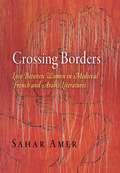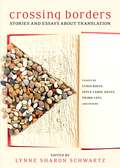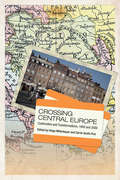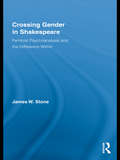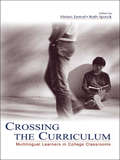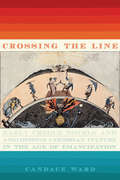- Table View
- List View
Cross-Word Modeling for Arabic Speech Recognition (SpringerBriefs in Speech Technology)
by Dia Abuzeina Moustafa ElshafeiCross-Word Modeling for Arabic Speech Recognition utilizes phonological rules in order to model the cross-word problem, a merging of adjacent words in speech caused by continuous speech, to enhance the performance of continuous speech recognition systems. The author aims to provide an understanding of the cross-word problem and how it can be avoided, specifically focusing on Arabic phonology using an HHM-based classifier.
Cross-border Shadow Education and Critical Pedagogy: Questioning Neoliberal and Parochial Orders in Singapore (Palgrave Studies on Global Policy and Critical Futures in Education)
by Glenn TohThis book explores critical pedagogy and issues relating to entrepreneurialism, commodification, and marketization in education, and their deleterious effects on student agency and subjectivity. The central theme of the book is a cross-border critical ethnographic study of the shadow education practices of an overseas Japanese business community in Singapore which draws attention to the elaborate extent to which families are engaged in shadow or cram tutoring practices as part of their children’s education, supported by the strong presence of overseas branches of well-established corporate tutoring businesses headquartered in Japan. The author ultimately critiques a banking approach to education, particularly in terms of its oppressive and dehumanizing outcomes, sustained by the inner workings of neoliberal forces and mercantilist ideologies.
Cross-cultural Communication and Aging in the United States (Routledge Communication Series)
by Jennings Bryant Hana S. Noor Al-DeenRecently, the communication discipline has devoted increasing energy toward the study of aging, yet most of the research has insufficiently addressed a crucial factor in communicative relationships--culture. Meanwhile, cross-cultural/intercultural communication has not adequately addressed the aging process. Combining three powerful elements--communication, aging, and culture--all of which have an increasingly profound impact on today's multicultural society, this book focuses on older Americans in various communicative contexts within the framework of their cultures. Composed of original research by experts in their respective fields, the book combines communication, aging, and culture for a unique examination of those elements in American society. Section 1 deals with perspectives in cross-cultural communication and aging. These perspectives both illustrate the issues that greatly affect the lives of our elders and suggest ways to improve their status. Section 2 showcases three American co-cultures: Hawaiian, Arab, and Mormon illustrate how language, attitudes, and mentoring can serve as the links for maintaining cross-generational continuity in multicultural society. Section 3 demonstrates that many American organizations frequently contribute to the hardships that both internal elder customers (employees) and external elder customers (residents and patients) must endure. Section 4 incorporates popular culture and aging. It presents the role of selective popular media in portraying our elders. Because Americans rely heavily on the media, their mediated perceptions can have a profound impact on their attitudes toward the older population. Designed as a reader or supplementary text for college students in communication, gerontology, anthropology, sociology, and other related fields, this text can also be used by professionals in gerontological service areas, by libraries, and as a personal reference. It offers extensive appendices, figures, and tables for additional reference.
Cross-cultural Genre Analysis: Investigating Chinese, Italian and English CSR reports (Routledge Studies in Linguistics)
by Danni YuThis unique monograph provides a theoretical and methodological account on how to do cross-cultural genre analysis with the aids of corpus tools. Cross-cultural genre analysis investigates how discourse communities from different cultural backgrounds use language to realize a particular genre. It can shed light on genre nature as well as cultural specificities. The book suggests five specific approaches in doing cross-cultural genre analysis: Investigating genre context; Approaching genre complexity; Exploring genre nature; Exploring culture specificity; and Focusing on specific communicative functions. Each of these approaches is illustrated and demonstrated in a specific chapter with practical analyses of the genre of CSR reports. Covering linguistic analysis of CSR reports in three languages: Chinese, English and Italian, Yu provides insights into implications for both genre theories and CSR communication practice. By applying the cross-cultural perspective in corporate discourse analysis, her book demonstrates how the approach of cross-cultural genre analysis is fruitful and valuable in providing practical insights into the textual practice of CSR reporting in a globalized context. Moreover, in the final parts of the book, Yu illustrates how cross-cultural genre analysis can be applied in the didactic field of writing, translation and cross-cultural studies. This volume is a valuable reference to scholars of genre analysis, corpus-based studies, cross-cultural studies and corporate communication. Moreover, it is also useful for professionals involved in compiling CSR reports. Armed with the knowledge imparted in this book, the reader should be able to analyze other genres from a cross-cultural perspective. In particular, instructions on how to use specific corpus tools are provided in the appendices, which can give scholars basic technical knowledge to approach the field of cross-cultural genre analysis.
Cross-linguistic Influences in Multilingual Language Acquisition (Second Language Learning and Teaching)
by Danuta Gabrys-BarkerThis volume depicts the phenomenon of cross-linguistic influences in the specific context of multilingual language acquisition. It consists of articles on various issues relating to the syntactic and lexical development of foreign language learners from different L1 backgrounds, in many cases involving languages which are typologically distant from English, such as Russian, Croatian, Greek and Portuguese. Individual chapters highlight different areas expected to be especially transfer-prone at the level of grammatical and lexical transfer in particular contexts of language contact.
Cross-talk in Comp Theory: A Reader
by Kristin L. Arola Victor VillanuevaThe 3rd edition of this invaluable anthology features eight new essays, including six in the new technology section, "Virtual Talk: Composing Beyond the Word," edited by Victor Villanueva and Kristin L. Arola. <p><p>For the third edition of Cross-Talk in Comp Theory, Victor Villanueva recruited the expertise of colleague Kristin L. Arola in order to flesh out the discussion on composition and technology. The quick movement of the paradigm—from the personal computer to local-area networks to the rise of social networking—suggests the need to recall the talk and the cross-talk concerning computers and their products for composition. <p><p>The award-winning Villanueva and his coeditor Arola have dropped nine essays from the second edition, reoriented others into new sections, and added eight new essays, including six in the new technology section, "Virtual Talk: Composing Beyond the Word." Amid these changes, the third edition maintains the historical perspective of previous editions while continuing to provide insights on the relatively new discipline of composition studies. <p><p>Landmark contributions by major figures such as Donald Murray, Janet Emig, Walter Ong, Sondra Perl, Mike Rose, and Patricia Bizzell remain. They are joined by the works of other trailblazing scholars such as Peter Elbow and Richard Ohmann. This edition also incorporates texts by key names within comp's conversations on technology, including Adam Banks, Cynthia Selfe, and Kathleen Blake Yancey. <p><p>The result is a collection that continues to provide new and experienced teachers and scholars with indispensable insights into the challenges, controversies, and ever-shifting currents within our rich and ever-evolving field.
Crosscultural Transgressions: Research Models in Translation: v. 2: Historical and Ideological Issues
by Theo HermansCrosscultural Transgressions offers explorations and critical assessments of research methods and models in translation studies, and points up new questions and directions. Ranging from epistemological questions of description and historiography to the politics of language, including the language of translation research, the book tackles issues of research design and methodology, and goes on to examine the kind of disciplinary knowledge produced in translation studies, who produces it, and whose interests the dominant paradigms serve. The focus is on historical and ideological problems, but the crisis of representation that has affected all the human sciences in recent decades has left its mark. As the essays in this collection explore the transgressive nature of crosscultural representation, whether in translations or in the study of translation, they remain attentive to institutional contexts and develop a self-reflexive stance. They also chart new territory, taking their cue from ethnography, semiotics, sociology and cultural studies, and tackling Meso-American iconic scripts, Bourdieu's constructivism, translation between philosophical paradigms, and the complexities of translation concepts in multicultural societies.
Crossing Borders
by Sahar AmerGiven Christianity's valuation of celibacy and its persistent association of sexuality with the Fall and of women with sin, Western medieval attitudes toward the erotic could not help but be vexed. In contrast, eroticism is explicitly celebrated in a large number of theological, scientific, and literary texts of the medieval Arab Islamicate tradition, where sexuality was positioned at the very heart of religious piety.In Crossing Borders, Sahar Amer turns to the rich body of Arabic sexological writings to focus, in particular, on their open attitude toward erotic love between women. By juxtaposing these Arabic texts with French works, she reveals a medieval French literary discourse on same-sex desire and sexual practices that has gone all but unnoticed. The Arabic tradition on eroticism breaks through into French literary writings on gender and sexuality in often surprising ways, she argues, and she demonstrates how strategies of gender representation deployed in Arabic texts came to be models to imitate, contest, subvert, and at times censor in the West.Amer's analysis reveals Western literary representations of gender in the Middle Ages as cross-cultural, hybrid discourses as she reexamines borders--cultural, linguistic, historical, geographic--not as elements of separation and division but as fluid spaces of cultural exchange, adaptation, and collaboration. Crossing these borders, she salvages key Arabic and French writings on alternative sexual practices from oblivion to give voice to a group that has long been silenced.
Crossing Borders, Drawing Boundaries: The Rhetoric of Lines across America
by Barbara Couture & Patti WojahnWith growing anxiety about American identity fueling debates about the nation’s borders, ethnicities, and languages, Crossing Borders, Drawing Boundaries provides a timely and important rhetorical exploration of divisionary bounds that divide an Us from a Them. The concept of “border” calls for attention, and the authors in this collection respond by describing it, challenging it, confounding it, and, at times, erasing it. Motivating us to see anew the many lines that unite, divide, and define us, the essays in this volume highlight how discourse at borders and boundaries can create or thwart conditions for establishing identity and admitting difference. Each chapter analyzes how public discourse at the site of physical or metaphorical borders presents or confounds these conditions and, consequently, effective participation—a key criterion for a modern democracy. The settings are various, encompassing vast public spaces such as cities and areas within them; the rhetorical spaces of history books, museum displays, activist events, and media outlets; and the intimate settings of community and classroom conversations. Crossing Borders, Drawing Boundaries shows how rich communication can be when diverse cultures intersect and create new opportunities for human connection, even while different populations, cultures, age groups, and political parties adopt irreconcilable positions. It will be of interest to scholars in rhetoric and literacy studies and students in rhetorical analysis and public discourse. Contributors include Andrea Alden, Cori Brewster, Robert Brooke, Randolph Cauthen, Jennifer Clifton, Barbara Couture, Vanessa Cozza, Anita C. Hernández, Roberta J. Herter, Judy Holiday, Elenore Long, José A. Montelongo, Karen P. Peirce, Jonathan P. Rossing, Susan A. Schiller, Christopher Schroeder, Tricia C. Serviss, Mónica Torres, Kathryn Valentine, Victor Villanueva, and Patti Wojahn.
Crossing Borders: Stories and Essays about Translation
by Lynne Sharon SchwartzIn Joyce Carol Oates’s story “The Translation,” a traveler to an Eastern European country falls in love with a woman he gets to know through an interpreter. In Lydia Davis’s “French Lesson I: Le Meurtre,” what begins as a lesson in beginner’s French takes a sinister turn. In the essay “On Translating and Being Translated,” Primo Levi addresses the joys and difficulties awaiting the translator. Lynne Sharon Schwartz’s Crossing Borders: Stories and Essays About Translation gathers together thirteen stories and five essays that explore the compromises, misunderstandings, traumas, and reconciliations we act out and embody through the art of translation. Guiding her selection is Schwartz’s marvelous eye for finding hidden gems, bringing together Levi, Davis, and Oates with the likes of Michael Scammell, Harry Mathews, Chana Bloch, and so many other fine and intriguing voices.
Crossing Boundaries in Researching, Understanding, and Improving Language Education: Essays in Honor of G. Richard Tucker (Educational Linguistics #58)
by Dongbo Zhang Ryan T. MillerThis volume brings together original papers from language education scholars from around the world to explore, exemplify, and discuss the multiplicity of boundary crossing in language education. It emphasizes the potential of boundary crossing for expansive learning, and aims to generate new insights, through boundary crossing, into the complexity of language education and approaches to innovative practices. This volume also underscores the important role of expert boundary crossers. In particular, it aims to honor G. Richard Tucker, Paul Mellon University Professor Emeritus of Applied Linguistics at Carnegie Mellon University, celebrating his distinguished scholarship on language education and paying tribute to the inspiration and mentorship he has given to the contributors of this volume to cross boundaries academically and professionally. This volume is organized into four sections, namely, language learning and development; teachers and instructional processes; program innovation, implementation, and evaluation; and language-in-education policy and planning. These sections or themes, which are necessarily cross-cutting, also represent the major areas of scholarship where Prof. Tucker has made distinguished contributions for over half a century.
Crossing Central Europe: Continuities and Transformations, 1900-2000
by Carrie Smith-Prei Helga MitterbauerCrossing Central Europe is a pioneering volume that focuses on the complex networks of transcultural interrelations in Central Europe from 1900 to 2000. Scholars from Canada, the United States, and Europe identify the motifs, topics, and ways of artistic creation that define this cross-cultural region. This interdisciplinary volume is divided into two historical periods and includes analyses of literature, film, music, architecture, and media. By focusing first on the interrelations in the nineteenth and early twentieth-century, the contributors reveal a complex trans-ethnic network at play that disseminated aesthetic ideals. This network continued to be a force of aesthetic influence leading into the twenty-first century despite globalization and the influence of mass media. Helga Mitterbauer and Carrie Smith-Prei have embarked on a study of the overlapping artistic influences that have outlasted both the National Socialist regime and the Cold War.
Crossing Cultures In The Language Classroom, Second Edition
by Andrea DeCapua Ann WintergerstCrossing Cultures in the Language Classroom attempts to balance theory and practice for pre-service and in-service teachers in general education programs or in ESL/EFL, bilingual, and foreign language teacher training programs, as well as cross-cultural awareness workshops. This book is unique in that it combines theory with a wide range of experiential activities and projects designed to actively engage users in the process of understanding different aspects of cross-cultural awareness. The goals of the book are to help readers: expand cultural awareness of one’s own culture and that of others achieve a deeper understanding of what culture is and the relationship between culture and language acquire the ability to observe behaviors in order to draw conclusions based on observation rather than preconceptions understand and implement observations of cultural similarities and differences develop an attitude of tolerance toward cultural differences and move away from the “single story.” The new edition has been thoroughly updated and includes a Suggested Projects section in each chapter. This section provides opportunities for users of the text to explore in greater depth an area and topic of interest. It also includes even more Critical Incidents--brief descriptions of events that depict some element or elements of cultural differences, miscommunication, or culture clash. Critical Incidents develop users’ ability to analyze and understand how multiple perspectives of the same situation are rooted in differing culturally influenced beliefs, behaviors, norms of interaction, and worldviews.
Crossing Divides: Exploring Translingual Writing Pedagogies and Programs
by Bruce Horner and Laura TetreaultTranslingualism perceives the boundaries between languages as unstable and permeable; this creates a complex challenge for writing pedagogy. Writers shift actively among rhetorical strategies from multiple languages, sometimes importing lexical or discoursal tropes from one language into another to introduce an effect, solve a problem, or construct an identity. How to accommodate this reality while answering the charge to teach the conventions of one language can be a vexing problem for teachers. Crossing Divides offers diverse perspectives from leading scholars on the design and implementation of translingual writing pedagogies and programs. The volume is divided into four parts. Part 1 outlines methods of theorizing translinguality in writing and teaching. Part 2 offers three accounts of translingual approaches to the teaching of writing in private and public colleges and universities in China, Korea, and the United States. In Part 3, contributors from four US institutions describe the challenges and strategies involved in designing and implementing a writing curriculum with a translingual approach. Finally, in Part 4, three scholars respond to the case studies and arguments of the preceding chapters and suggest ways in which writing teachers, scholars, and program administrators can develop translingual approaches within their own pedagogical settings. Illustrated with concrete examples of teachers’ and program directors’ efforts in a variety of settings, as well as nuanced responses to these initiatives from eminent scholars of language difference in writing, Crossing Divides offers groundbreaking insight into translingual writing theory, practice, and reflection. Contributors: Sara Alvarez, Patricia Bizzell, Suresh Canagarajah, Dylan Dryer, Chris Gallagher, Juan Guerra, Asao B. Inoue, William Lalicker, Thomas Lavelle, Eunjeong Lee, Jerry Lee, Katie Malcolm, Kate Mangelsdorf, Paige Mitchell, Matt Noonan, Shakil Rabbi, Ann Shivers-McNair, Christine M. Tardy
Crossing Gender in Shakespeare: Feminist Psychoanalysis and the Difference Within (Routledge Studies In Shakespeare Ser. #3)
by James W. StoneIn this book, Stone effects a return to gender, after many years of neglect by Twenty-First-Century critics, via a methodology of close reading that foregrounds moments of sexual decentering and disequilibrium within the text and in the interstices of the dialogue between Shakespeare and his critics. Issues addressed range from the cross dressing of Viola and Imogen to the cross gartering of Malvolio, the sound of "un" and the uncanny lyric narcissism of Richard II, Hamlet’s misogyny, androgyny, and the poison of marital/political "union," Othello’s fears of impotence, rumors of Antony’s emasculation versus the militant yet nurturing triumphalism of Cleopatra’s suicide, and Posthumus’s hysterical reaction to the "woman’s part" in himself and his compensatory fantasies of parthenogenesis. Stone unpacks ideologically powerful but unsustainable male claims to self-identity and sameness, set over against man’s type-gendering of women as the origin of divisive sexual difference, discord, and the dissolution of marriage. Men who blame women for the difference that divides and weakens their sense of unity and sameness to oneself are unconscious that the uncanny feminine is not outside the masculine, its reassuring canny opposite; it is inside the masculine, its uncanny difference from itself.
Crossing Into America: The New Literature of Immigration
by S. Shankar Louis MendozaThis outstanding collection captures the diverse voices of the new literature of American immigration. Bringing together beautiful writing from celebrated authors such as Sandra Cisneros, Jamaica Kincaid, Maxine Hong Kingston, and Chang-Rae Lee, Crossing into America fills the literary void in public discussion about immigration. Since the immigration reforms of 1965 removed many of the racial barriers in American immigration laws, a new wave of immigrants has visibly transformed a society that has long prided itself on being a nation of immigrants. Crossing into America includes stories and memoirs of writers born in Mexico, Kashmir, the Philippines, South Africa, and Romania, as well as poignant reflections on the immigrant experience by the children of immigrants. This book follows these newest arrivals--from their home countries through their engagement with America--and also includes an accessible history of immigration policy, cartoons, newspaper stories, and a section of conversations with activists, journalists, and scholars working on the front lines of our immigration battles.
Crossing Ocean Parkway
by Marianna D. TorgovnickGrowing up an Italian-American in the Bensonhurst neighborhood of New York city, Marianna De Marco longed for college, culture, and upward mobility. Her daydreams circled around WASP (White Anglo Saxon Protestant) heroes on television--like Robin Hood and the Cartwright family--but in Brooklyn she never encountered any. So she associated moving up with Ocean Parkway, a street that divides the working-class Italian neighborhood where she was born from the middle-class Jewish neighborhood into which she married. This book is Torgovnick's unflinching account of crossing cultural boundaries in American life, of what it means to be an Italian American woman who became a scholar and literary critic. Included are autobiographical moments interwoven with engrossing interpretations of American cultural icons from Dr. Dolittle to Lionel Trilling, The Godfather to Camille Paglia. Her experiences allow her to probe the cultural tensions in America caused by competing ideas of individuality and community, upward mobility and ethnic loyalty, acquisitiveness and spirituality.
Crossing Ocean Parkway
by Marianna De Marco TorgovnickGrowing up an Italian-American in the Bensonhurst neighborhood of New York city, Marianna De Marco longed for college, culture, and upward mobility. Her daydreams circled around WASP (White Anglo Saxon Protestant) heroes on television—like Robin Hood and the Cartwright family—but in Brooklyn she never encountered any. So she associated moving up with Ocean Parkway, a street that divides the working-class Italian neighborhood where she was born from the middle-class Jewish neighborhood into which she married. This book is Torgovnick's unflinching account of crossing cultural boundaries in American life, of what it means to be an Italian American woman who became a scholar and literary critic. Included are autobiographical moments interwoven with engrossing interpretations of American cultural icons from Dr. Dolittle to Lionel Trilling, The Godfather to Camille Paglia. Her experiences allow her to probe the cultural tensions in America caused by competing ideas of individuality and community, upward mobility and ethnic loyalty, acquisitiveness and spirituality.
Crossing Ocean Parkway: With a New Afterword
by Marianna De Marco TorgovnickGrowing up an Italian-American in the Bensonhurst neighborhood of New York city, Marianna De Marco longed for college, culture, and upward mobility. Her daydreams circled around WASP (White Anglo Saxon Protestant) heroes on television—like Robin Hood and the Cartwright family—but in Brooklyn she never encountered any. So she associated moving up with Ocean Parkway, a street that divides the working-class Italian neighborhood where she was born from the middle-class Jewish neighborhood into which she married. This book is Torgovnick's unflinching account of crossing cultural boundaries in American life, of what it means to be an Italian American woman who became a scholar and literary critic. Included are autobiographical moments interwoven with engrossing interpretations of American cultural icons from Dr. Dolittle to Lionel Trilling, The Godfather to Camille Paglia. Her experiences allow her to probe the cultural tensions in America caused by competing ideas of individuality and community, upward mobility and ethnic loyalty, acquisitiveness and spirituality.
Crossing Over: Teaching Meaning-centered Secondary English Language Arts
by Harold M. FosterThis text for secondary preservice and in-service English language arts teachers offers a rationale for meaning-centered English language arts teaching and practical strategies for application. Its goal is to provide readers with an understanding of the issues involved in English teaching and specific examples of how to apply this understanding to classrooms. Teaching strategies are presented through a series of stories depicting teachers from a variety of settings practicing their craft with secondary students. Features: *A solid introduction and interesting personal narratives introduce the issues and ideas involved in English language arts teaching. *Case studies based on actual teachers and students realistically illustrate methods that can be used in secondary English classes. *Lessons are described in sufficient detail to be converted to teaching models. *Multicultural emphasis prepares teachers for the contemporary classroom. *Chapters and sections incorporate the new literacies of TV, film, and computers in the English language arts class. *Pedagogical aids include end-of-chapter questions and activities, reproducible charts and worksheets; an updated listing of young adult novels; and annotated recommended readings. *An appendix on writing a personal narrative helps students develop as writers. New in the Second Edition: *Updates. All chapters, the bibliographies, and the references are thoroughly updated to reflect changes since the first edition was published. Chapters 1 and 2 have been totally rewritten. *Standards/Benchmarks. The IRA/NCTE Standards for the English Language Arts are incorporated into the text. Benchmarks and Performance Assessment Measures are included in all the pedagogical chapters to address proficiency concerns. A section on helping students prepare for state proficiency tests has been added. *Computers. More is included on the use of technology, both as a content to learn and as a process for learning. *New Sample Unit Plans. Sections based on the instructional stories offer examples to help readers prepare for teaching. *Literature response questions. These are now provided in Chapter 4 for use in journaling and discussions. *Glossary. A chapter on important terms and useful strategies for the English language arts classroom has been added.
Crossing Sex and Gender in Latin America
by Vek LewisSignifying 'others' or signs of life? This book critically examines the ways in which crossing sex and gender is imagined in key cultural texts from contemporary Latin America.
Crossing the Border: On the Quadruple-Evidence Method
by Li Yang Shuxian YeThis book is the first monograph of its kind in the academic world which comprehensively expounds the new methodology of humanities. The quadruple-evidence method is one which integrates quadruple-evidences to open up new horizon for interpretation of ancient culture in the three-dimensional manner. The first layer of evidence refers to documents passed down from the past; the second layer of evidence refers to local written materials; the third layer of evidence includes oral legends of anthropology and folklore and etiquette in the living folk customs; the fourth layer of evidence refers to those ancient objects and images either unearthed in archaeological excavations or handed down from the past. The book consists of theoretical explorations and their applications in individual cases. While the first part studies the academic evolution, theory and methodological value of the quadruple-evidence method, the second part, in using the method in different cases, explores different historical and cultural phenomena in the history of China, attempting to extend the frontier of the origin of civilization from the approach of mythological study
Crossing the Creek: The Literary Friendship of Zora Neale Hurston and Marjorie Kinnan Rawlings
by Anna LilliosOne of the twentieth century's most intriguing and complicated literary friendships was that between Zora Neale Hurston and Marjorie Kinnan Rawlings. In death, their reputations have reversed, but in the early 1940s Rawlings had already achieved wild success with her best-selling and Pulitzer Prize-winning novel, The Yearling, while Hurston had published Their Eyes Were Watching God to unfavorable critical reviews.When they met, both were at the height of their literary powers. Hurston appears to have sought out Rawlings as a writer who could understand her talent and as a potential patron and champion. Rawlings did become an advocate for Hurston, and by all accounts a warm friendship developed between the two. Yet at every turn, Rawlings's own racism and the societal norms of the Jim Crow South loomed on the horizon, until her friendship with Hurston transformed Rawlings's views on the subject and made her an advocate for racial equality.Anna Lillios's Crossing the Creek is the first book to examine the productive and complex relationship between these two major figures. Is there truth to the story that Hurston offered to work as Rawlings's maid? Why did Rawlings host a tea for Hurston in St. Augustine? In what ways did each write the friendship into their novels? Using interviews with individuals who knew both women, as well as incisive readings of surviving letters, Lillios examines these questions and many others in this remarkable book.
Crossing the Curriculum: Multilingual Learners in College Classrooms
by Ruth Spack Vivian ZamelAs college classrooms have become more linguistically diverse, the work of ESOL professionals has expanded to include research on the experiences of multilingual learners not only in ESOL courses but also in courses across the curriculum. At the same time that ESOL professionals are trying to understand the academic challenges that learners face beyond ESOL courses, faculty across the disciplines are trying to meet the challenge of teaching students of differing linguistic backgrounds. Crossing the Curriculum: Multilingual Learners in College Classrooms responds to these issues and concerns by capturing the complex and content-specific nature of students' and teachers' experiences and providing a nuanced understanding of how multilingual students' learning can be fostered and sustained. Crossing the Curriculum: Multilingual Learners in College Classrooms is unique in bringing together the perspectives of researchers, students, and teachers. These multiple lenses allow for a richly layered picture of how students and teachers actually experience college classrooms. Common themes and pedagogical principles resonate across the three distinct sections of the book:*Part One, "Investigating Students' Experiences Across the Curriculum: Through the Eyes of Classroom Researchers," consists of chapters written by ESOL and composition researchers who have investigated multilingual students' experiences in undergraduate courses across the curriculum.*Part Two, "Learning Across the Curriculum: Through Students' Eyes," consists of chapters written by two multilingual learners who chronicled their experiences as they crossed the curriculum over time.*Part Three, "Engaging Students in Learning: Through the Eyes of Faculty Across the Curriculum," consists of chapters written by faculty from several academic fields--Anthropology, Philosophy, Nursing, Literature, Sociology, and Asian American Studies--who discuss their own attempts to address the needs of multilingual learners in their classrooms.
Crossing the Line: Early Creole Novels and Anglophone Caribbean Culture in the Age of Emancipation (New World Studies)
by Candace WardCrossing the Line examines a group of early nineteenth-century novels by white creoles, writers whose identities and perspectives were shaped by their experiences in Britain’s Caribbean colonies. Colonial subjects residing in the West Indian colonies "beyond the line," these writers were perceived by their metropolitan contemporaries as far removed—geographically and morally—from Britain and "true" Britons. Routinely portrayed as single-minded in their pursuit of money and irredeemably corrupted by their investment in slavery, white creoles faced a considerable challenge in showing they were driven by more than a desire for power and profit. Crossing the Line explores the integral role early creole novels played in this cultural labor. The emancipation-era novels that anchor this study of Britain's Caribbean colonies question categories of genre, historiography, politics, class, race, and identity. Revealing the contradictions embedded in the texts’ constructions of the Caribbean "realities" they seek to dramatize, Candace Ward shows how these white creole authors gave birth to characters and enlivened settings and situations in ways that shed light on the many sociopolitical fictions that shaped life in the anglophone Atlantic.
